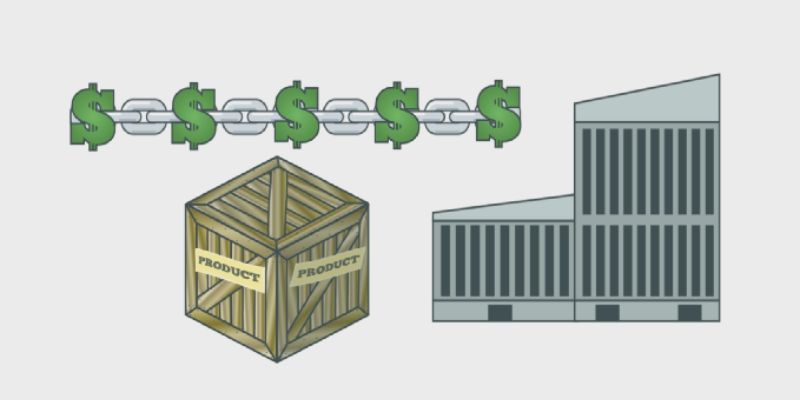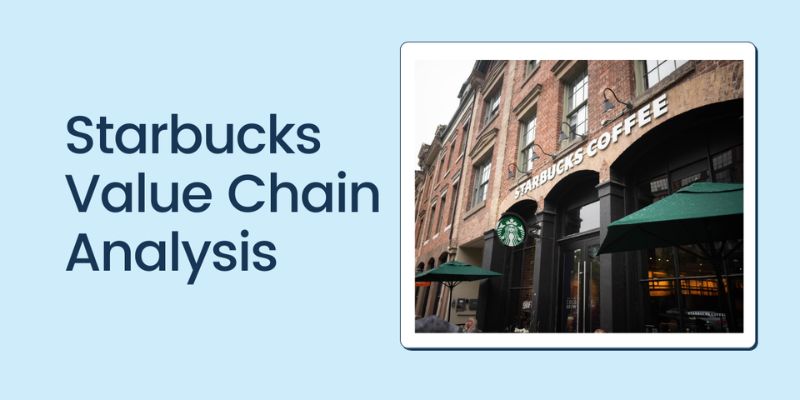Analyzing Starbucks’ Value Chain
Jul 30, 2023 By Rick Novak
For those of us in the business world, Starbucks is quite possibly (and probably!) the quintessential example of a successful and established business.
With thousands of retail stores, an array of delicious coffee and food offerings, a long-standing commitment to its stakeholders, and innovation in its supply chain management strategies, Starbucks has firmly entrenched itself into daily life for many people across the globe.
In this blog post, we will dive deep into understanding what makes up the Starbucks value chain and analyze how each element contributes to creating quality products, services, and experiences that customers have come to enjoy over time.
So get yourself a nice hot cup of Joe – or maybe some tea? – as we explore what's behind this globally renowned brand!
Value Chain Basics

At the heart of a business's value chain are its primary activities, which include inbound logistics, operations, outbound logistics, marketing and sales, and services.
These activities play an important role in production by ensuring that materials are procured from suppliers efficiently, operations are conducted with maximum efficiency to produce high-quality output, and the product is marketed and sold effectively. Additionally, customer service is key as it helps ensure customer loyalty.
Supporting these primary activities are secondary activities such as procurement of resources, technology development, infrastructure management, human resource management, and firm strategies.
Assessing each of these elements within a company's value chain model helps managers to identify areas where they can create a competitive advantage for their firm.
Gross Profit Margin
Starbucks consistently maintains a high gross profit margin, ranging from 58.7-60.3% over the past 3 years, indicating that its supply chain strategies effectively and efficiently drive value for the company.
This is because Starbucks has maintained an optimum balance of cost-effectiveness while ensuring quality products across its locations worldwide.
The company minimizes costs by leveraging technology to streamline processes, such as utilizing automated inventory management systems that accurately track what supplies must be replenished and where they should be shipped.
Starbucks also uses data analytics solutions to monitor customer preferences and optimize product offerings accordingly.
Operating Margin
At Starbucks, operating margin is a key determinant of how well the company can create value from its processes and activities. Operating margins at Starbucks have consistently been between 18-20% since 2010, illustrating that the company has become very efficient in managing its indirect costs like research, marketing, administration, etc.
Furthermore, when analyzing Starbucks's performance on an operating basis, it is clear that the company has been able to effectively manage its resources and capitalize on strategic opportunities to maximize profits.
As a result of this efficiency, Starbucks can attract customers with high-quality products and services while ensuring healthy profitability.
Value Chain Analysis

The Starbucks value chain starts with the primary activities of product development, operations, marketing and sales, and customer service. From there, most of the company's efforts are centered on enhancing these activities so customers can have a seamless experience.
In terms of its product development, Starbucks ensures quality by sourcing premium coffee beans from around the world and developing unique recipes and products to exceed customer expectations. The operation function focuses on efficient processes such as inventory management and maintaining accurate records to maximize efficiency.
Marketing and sales include traditional channels such as radio ads, print media campaigns, television commercials, and digital platforms like social media campaigns. Additionally, they leverage loyalty programs for existing customers to increase retention rates.
Finally, customer service is a cornerstone of the Starbucks value chain. The company focuses on providing an outstanding experience to customers through its baristas and other in-store staff. Customer feedback is considered to ensure that each store offers the best possible service and product quality.
Starbucks' Primary Activities
Inbound Logistics
Starbucks works with many suppliers to source materials like coffee beans, milk, and other ingredients for their food offerings. The company has strict standards when selecting its vendors to ensure the consistent quality of the products supplied to Starbucks' stores.
Additionally, they use technology such as RFID (Radio Frequency Identification) tags to track shipments from supplier warehouses through delivery into retail locations. This allows them to monitor inventory levels and replenish stores quickly when needed.
Operations
At each store location, employees must be well-trained to deliver the best customer experience. All Baristas receive extensive instruction on preparing beverages based on the company's standards.
This includes measuring ingredients correctly, operating machines with safety and accuracy, and customer service training.
Additionally, Starbucks has a program called "Bean-to-Cup," which helps to connect its supply chain directly to its retail stores by having its suppliers roast the coffee beans in their facilities and then ship them straight to store locations, ready for use.
Outbound Logistics
Starbucks also uses outbound logistics to get products from their stores into customers' hands as quickly and efficiently as possible. They offer delivery services for orders placed online or via their mobile app, plus they partner with various third-party delivery companies such as Uber Eats and Postmates to increase their reach.
Marketing and Sales
Starbucks' marketing strategy focuses on developing a strong brand identity and creating customer loyalty with its Starbucks Rewards program. They also use digital marketing to promote new products and deals for customers to keep them engaged.
Additionally, the company continuously works on introducing new product lines and special seasonal offerings to drive sales.
Service
At the core of Starbucks is its commitment to providing excellent customer service at each store location. Employees are trained to ensure that all delivered orders are of the highest quality possible while demonstrating a friendly approach when interacting with customers.
Additionally, they offer various programs such as "My Starbucks Rewards," which allows customers to earn rewards and discounts based on their purchases.
By leveraging the five primary activities that make up its value chain, Starbucks can consistently create high-quality products and deliver excellent customer service. This has enabled them to become one of the most recognizable brands in the world and an industry leader in retail coffee sales.
Starbucks' Support Activities
In addition to the primary activities that make up their value chain, Starbucks has a few additional support activities that help drive customer satisfaction and operational efficiency. These include the following:
- Resource Management: Starbucks has invested in software that helps them manage their inventory and track order fulfillment. This allows them to ensure stock availability at each store location while optimizing delivery times for customers ordering through third-party services or online.
- Technology Development: The company is always looking for ways to improve its products through technology by designing new machines for preparing beverages faster or developing more efficient processes. Additionally, Starbucks regularly updates its mobile apps to offer better experiences for customers using its services.
- Human Resources Management: Starbucks focuses on providing a positive work environment for its employees. This includes offering competitive salaries and benefits and career development opportunities to help them grow within the company.
- Procurement: The company applies stringent standards when selecting its suppliers to maintain quality control. They also focus on creating long-term relationships with vendors to ensure they have consistent access to materials needed for their products.
- International Expansion: Starbucks has opened stores worldwide to reach new customers and expand its customer base. This helps them leverage economies of scale by expanding into markets with higher potential returns while maintaining quality standards across all locations.
FAQs
What Is the Value Chain of a Coffee Shop?
The value chain of a coffee shop describes the steps and processes needed to produce and deliver coffee products from beginning to end. This includes sourcing materials, operation management (baristas), outbound logistics (delivering orders), marketing/sales, and customer service.
What Are Support Activities in Value Chain Analysis?
Support activities in value chain analysis are additional activities that help make up the company's overall value chain but don't directly contribute to the production process. These include resource management, technology development, human resources management, procurement, and international expansion.
How Does Starbucks Manage Its Supply Chain?
Starbucks manages its supply chain by selecting suppliers based on stringent quality standards, using RFID tags to track shipments from warehouses to stores, and working with third-party delivery companies to increase its reach. Additionally, the company has invested in software to help manage inventory and order fulfillment.
Conclusion
Starbucks has found ways to stay competitive in a highly saturated market by innovating and utilizing its value chain. By evaluating its primary and support activities, the coffee giant can realize which areas need improvement and additional funds to meet customer needs and increase profits. The impressive profits generated from their portfolio of offerings give us insight into their mastery of the value chain concept.








